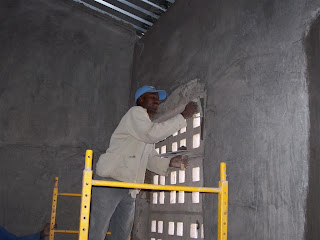After the closing prayer the group split up into their designated jobs for the day. Two ladies went directly to the mud-pit, three men headed for the cement mixer, the bricklayers started climbing the scaffolds, the welder and his helper attacked the security gates, and the remainder of workers began their duties as "support" personnel. Maybe some of the job descriptions need a bit more definition for you that are not familiar with the African building process.
The mud-pit... this is the really interesting job for sure. We are using clay blocks to build the church. These blocks are made on-site using a mixture of clay, sand and water. Building with these blocks require the same clay, sand and water mixture for mortar. So, the two ladies hand mix the "managwa" (local dialect for mortar) for the bricklayers to use. I promise to post pictures and tell you the process of the actual brick making at a later time. You will be amazed at the process and the back-breaking work involved!
Support personnel... these guys do what ever is needed at the time. They carry bricks for the bricklayers. They make sure they have mortar when needed. They tear down and re-build the scaffolds when needed. Without these guys the work would be really slow at best.
Today, slurry was applied to the bricks that were laid yesterday. Slurry is a really wet mixture of cement mortar that is thrown on the surface of the clay blocks. When this slurry dries it becomes the bonding agent that holds the plaster in place when it is applied. The slurry will dry for at least two days before the plaster process begins. There is only a 5 metre section of the building that is not already plastered. After the plaster dries it can then be painted.
Here are a few pictures of the workers in action...
.jpg)
.jpg)
.jpg)
.jpg)
.jpg)
Keeping the work site clean is a never-ending job. None of the guys like doing this, but they all know that when they are not "busy" with another job they have to pitch in and help keep everything as clean as possible.
Here are a few pictures of the building and surrounding area.
.jpg)
.jpg)
.jpg)
No comments:
Post a Comment